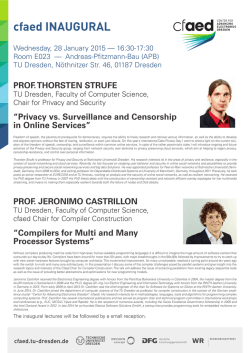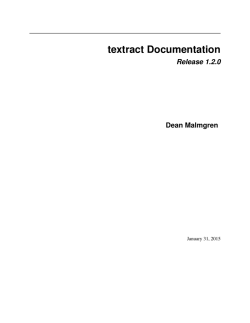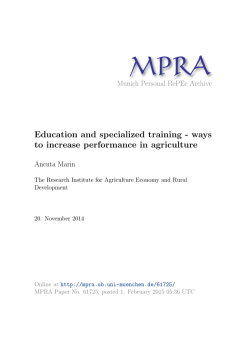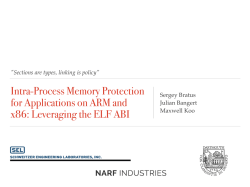
easwari engineering college, chennai
EASWARI ENGINEERING COLLEGE, CHENNAI-600 089 DEPARTMENT OF COMPUTER SCIENCE AND ENGINEERING LESSON PLAN SUBJECT CODE : CS 2352 SUBJECT TITLE : PRINCIPLES OF COMPILER DESIGN HOURS DISTRIBUTION : (L T P C 3 0 2 4) COURSE/ BRANCH : B.E. (CSE) SEMESTER : VI ACADEMIC YEAR : 2014 - 2015 FACULTY NAME : DR.G.S.ANANDHA MALA OBJECTIVE OF COURSE : To understand the principles of compiler design. This goal will be achieved by introducing compiler design and implementation techniques and theory, reading current compiler development literature, and discussing the design and implementation of components of a compiler. This course will emphasize the implementation of a compiler through the development of a large, complex, well-structured software system that implements phases of a compiler such as the scanner, parser, and code generator. Additionally, students will be able to describe the design of a compiler including its phases and components, describe current developments in compiler design and implementation, identify similarities and differences among various parsing techniques, and transform grammars into parable forms. 1 OUTCOME OF COURSE : At the end of the course, the student should be able to: Ability to create lexical rules and grammars for a programming language. Ability to implement a parser such as a bottom-up SLR parser without using Yacc or any other compiler-generation tools. Ability to implement semantic rules into a parser that performs attribution while parsing. Be familiar with compiler architecture. Ability to design a compiler for a concise programming language. PREREQUISTE UNITS TOPIC NO : KNOWLEDGE IN THOREY OF COMPUTATION TOPIC PERIOD BOOKS Page REFERRED No UNIT-I (9+6) LEXICAL ANALYSIS I 1 OBJECTIVE: To learn the basic concepts, phases and types of various translators and to design and implement a lexical analyzer. Introduction to Compilers 1-4 1 T1 2 Analysis of the Source Program 2 T1 4-8 3 Phases of a Compiler 3 T1 8-13 4 Cousins of a Compiler, Grouping of the Phases 4 T1 13-16 5 Compiler Construction Tools 5 T1 16-18 6 Lexical Analysis 6 T1 18-19 7 Role of Lexical Analyzer 7 T1 69-70 8 Input Buffering- Specification of Tokens 8 T1 70-73 9 Recognition of Tokens, A language for specifying lexical analyzer Program implementation of Token separation for keyword/special character /function 9 T1 73-80 10 12 LAB 11 Program implementation of Token separation for identifier and constants 2 15 II UNIT-II (9+6) SYNTAX ANALYSIS and RUN-TIME ENVIRONMENTS 1 OBJECTIVE: To learn the role of a parser and to study the different ways of recognizing and parsing of tokens. Role of Parsers 130-134 16 T1 2 Grammars-CFGs 17 T1 135-140 3 Top Down Parsing-RD Parsing 18 T1 147-149 4 Bottom Up Parsing, Shift Reduce Parsing 19 T1 158-164 5 LR Parsing 20 T1 174-178 6 SLR Parsing 21 T1 179-185 7 Type checking, Specifications of simple type checker 22 T1 277-281 8 Run time environments, Source language issues 23 T1 297-302 9 24 T1 303-308 10 Storage organization, Storage allocation strategies, Static allocation Program implementation of Top down parser 11 Program implementation of Bottom up parser 30 27 LAB UNIT-III (9+6) INTERMEDIATE CODE GENERATION OBJECTIVE: To study the process of Intermediate Code generation III 1 Intermediate Languages 31 T1 334-339 2 Implementation of three address statements 32 T1 339-341 3 Declarations in a procedure 33 T1 341-343 4 Declarations-keeping track of scope & records 34 T1 343-345 5 Assignment Statements 35 T1 346-350 6 Boolean Expressions 36 T1 354-361 7 Case Statements 37 T1 361-364 8 Back Patching 38 T1 364-366 9 Procedure Calls 39 T1 366-368 10 Program implementation of Intermediate code generation as Quadruple Program implementation of Intermediate code generation continued 42 11 3 LAB 45 UNIT-IV (9+6) CODE GENERATION OBJECTIVE: To study the concepts of code generation, Run time storage management and different approaches of Compiler development. IV 1 Issues in the design of Code Generator 46 T1 371-375 2 The Target Machine 47 T1 375-378 3 Runtime Storage Management 48 T1 378-383 4 Basic Blocks and Flow Graphs 49 T1 383-388 5 Next Use Information 50 T1 388-389 6 A simple Code Generator 51 T1 389-394 7 Register allocation and Assignment 52 T1 394-397 8 DAG Representation of Basic Blocks 53 T1 398-403 9 Generating code from DAGs 54 T1 403-407 10 Program implementation of generation of object code from Intermediate code Program implementation of Code generation continued 57 LAB 11 60 UNIT-V (9+6) CODE OPTIMIZATION OBJECTIVE: To study the concepts of Code Optimization V 1 Introduction to Code optimization 61 T1 427-432 2 Principle of Sources of Optimization 62 T1 432-438 3 Peep hole Optimization 63 T1 438-441 4 Optimization of basic Blocks 64 T1 441-444 5 Loops in flow graphs 65 T1 444-449 6 Intro. Global Data Flow Analysis 66 T1 449-455 7 Dealing with loops 67 T1 456-461 8 Code improving transformations 68 T1 469-475 9 Alternative code motion 69 T1 476-483 10 Program implementation of code optimization 72 11 Program implementation of code optimization continued 75 4 LAB ASSIGNMENT TOPICS Sl. NO ASSIGNMENT TOPICS SUBMISSION DUE 1 ASSIGNMENT PROBLEM IN NFA TO DFA January 29 2015 2 ASSIGNMENT PROBLEM IN TOP DOWN AND BOTTOM UP PARSER ASSIGNMENT PROBLEM IN INTERMEDIATE CODE GENERATOR February 16 2015 3 March 16 2015 CONTENT BEYOND SYLLABUS SL.NO 1 2 ADDITIONAL TOPICS LEX COMPILER PARSER GENERATOR YACC TEXT BOOK T1. Alfred Aho, Ravi Sethi, Jeffrey D Ullman, “Compilers Principles, Techniques and Tools”, Pearson Education Asia, 2007. REFERENCE BOOKS R1. David Galles, “Modern Compiler Design”, Pearson Education Asia, 2007. R2. Steven S. Muchnick, “Advanced Compiler Design & Implementation”,Morgan Kaufmann Pulishers, 2000.. R3. C. N. Fisher and R. J. LeBlanc “Crafting a Compiler with C”, Pearson Education, 2000 5 PROGRAMME EDUCATIONAL OBJECTIVES 1. Graduates will have sound foundation in the mathematical, scientific and engineering fundamentals, necessary to formulate, analyze and solve engineering problems. 2. Graduates will possess the ability to think logically and have capacity to understand technical problems and to design optimal solutions for a successful career in industry or academia. 3. Graduates will have the potential to apply current industry practices and technologies to analyze, design, implement, test and verify computing systems with emphasis on security to address research problems and real world challenges 4. Graduates will have the ability to work as a team in both national and multinational environments and will be able to promote the design and implementation of products and services through strong interpersonal skills, leadership quality and entrepreneurial skills. 5. Graduates will possess an urge to learn continuously and to be responsive to the demands of the progressive industrial world by carrying out researches in frontier areas of computer science and engineering. 6. Graduates will be able to provide solutions to engineering problems with an understanding of its impact on economical, environmental, ethical, and societal considerations by ensuring professional standards. PROGRAMME OUTCOMES (a-l) (a) Apply the knowledge of mathematics, science and engineering fundamentals. (b) Ability to analyze a problem, identify and define the computing requirements appropriate to its solution. (c) Ability to design, implements, and evaluate a computer-based system, process, component, or program to meet desired needs. (d) Apply the research-based knowledge and research methods to identify, formulate and solve (e) (f) (g) (h) (i) (j) (k) (l) engineering problems. Ability to use the techniques, skills, and modern engineering tools necessary for engineering practice, with an understanding of the limitations. Demonstrate understanding of the societal, health, safety, legal and cultural issues and the consequent responsibilities relevant to engineering practice. Understand the impact of professional engineering solutions in a societal and environmental context and demonstrate the need for sustainable development. Understand and commit to professional ethics and responsibilities. Function effectively as an individual, and as a member in multi-disciplinary settings. Communicate effectively with the engineering community and with society at large, such as being able to comprehend, write effective reports and design documentation, make effective presentations, and give/ receive clear instructions. Demonstrate knowledge and understanding of the engineering and management principles, and apply these to one’s own work, as a member and leader in a team, to manage projects in multidisciplinary environments. Recognize the need for, and have the ability to engage in independent and life-long learning 6 MAPPING OF COURSE OUTCOMES WITH PEO & THE PROGRAMME OUTCOME-PRINCIPLES OF COMPILER DESIGN (CS2352) UNITS Unit –I LEXICAL ANALYSIS Unit –II SYNTAX ANALYSIS and RUN-TIME ENVIRONMENTS Unit-III INTERMEDIATE CODE GENERATION Unit –IV CODE GENERATION Unit –V CODE OPTIMIZATION Content Beyond Syllabus COURSE OUTCOME Ability to create lexical rules and grammars for a programming language Ability to implement a parser such as a bottom-up SLR parser without using Yacc or any other compilergeneration tools Ability to implement semantic rules into a parser that performs attribution while parsing Be familiar with compiler architecture Ability to design a compiler for a concise programming language Be familiar with compiler architecture Ability to design a compiler for a concise programming language PROGRAMME EDUCATIONAL OBJECTIVES PROGRAMME OUTCOMES 1 2 3 4 5 6 a b c d e SS SS S S M M SS SS SS S S SS SS S S M M SS SS SS MS M SS SS S S M M SS SS SS MS SS SS S S M M SS SS SS SS SS S S M M SS SS SS SS S S M M SS SS SS S S M M SS SS SS S M M STRONG MEDIUM WEAK 7 h i M M M MS SS SS SS SS S M W f g j k l S M S S SS M SS M S SS M SS M M S SS M SS MS M M S SS M SS SS MS M M S SS M SS SS SS MS M M S SS M SS SS SS MS M M S SS M SS
© Copyright 2026




